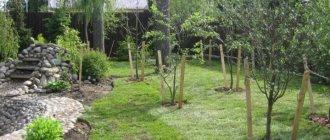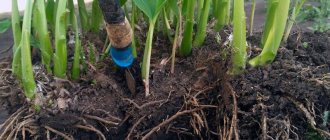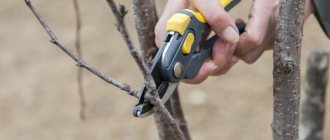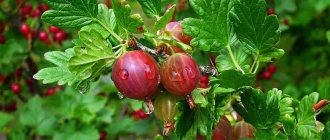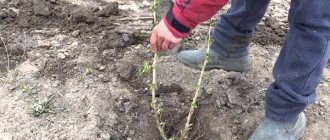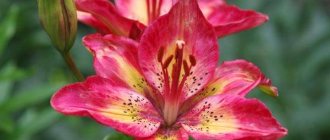Time to transplant trees in autumn
Agrotechnical practice shows that autumn (especially late) is the best time to transplant all types of deciduous and coniferous trees. The natural state of rest allows representatives of all species to comfortably tolerate interference in the natural process.
The optimal time for replanting trees is in the fall - from the beginning of leaf fall until the ambient temperature drops to minus fifteen degrees.
In conditions of persistent cooling (in the middle zone this is mid-October to mid-late November), all deciduous (including fruit) trees can be replanted. Naturally, the best air temperature for such work is from ten to zero degrees. At sub-zero values, additional operations are needed to protect not only the root system itself from freezing, but also to maintain positive soil temperatures around the transplant pit and backfill soil.
For conifers, the best time to transplant is early autumn and early spring.
Plants from other nurseries, taken in advance, should be temporarily buried until the required temperature minimum occurs, if they have an open root system. Seedlings with a closed root system will easily stand until the right time.
How to properly transplant a young tree
General rules
Young trees are more difficult to replant than mature ones. There are several important nuances here. Basically, the principles of transplanting young trees are no different from other plants.
For transplant you will need:
- Spatula.
- Woven or plastic fabric.
- A source of moisture for irrigation, such as a container of water.
- A small healthy seedling.
The transplant takes place in several stages:
- First you need to choose a suitable seedling. Its root system should be such that the plant can be easily placed in the ground. Therefore, it is better to take small sprouts. The tree seedling should tolerate transplantation well. True, it is not always possible to find out before landing. Thus, it is known that oak, magnolia, birch, eucalyptus, tea tree and dogwood tolerate transplantation well.
- When the seedling has been selected, you need to prepare a place for planting. For a tree to take root, the new conditions must be similar to those to which it is accustomed. That is, you need to observe soil moisture, intensity of solar radiation and method of water drainage.
- A hole of suitable size is dug at the selected location. Its depth depends on the dimensions of the root system. The roots should be located at the same depth as before. If the soil is too dense, then in this case you will need to dig a hole of a larger diameter. Otherwise, the roots will not be able to break through.
- As for fertilizing planted seedlings, this is usually not done until they have taken root. If this rule is not followed, this will lead to accelerated growth of the plant, which, in turn, will be a heavy load on the roots.
- After this, you need to dig up the seedling. To do this, first take a sharp spatula with a rounded edge, with which you mark the edge of the tree's root system at a distance of at least 280 mm. This will most likely ensure that the shovel will not touch the roots when digging.
- Then, along the intended line, the blade is forcefully immersed into the ground, as deep as possible. If the soil is too dry, it is best to moisten it first. From damp soil, a tree can be dug up without disturbing the roots. If the soil contains a lot of sand, then a special device (fixer) will be required to hold the roots of the seedling during the transplanting process.
- Now we carefully pull the dug tree out of the ground. To do this, you need to take it by the base of the trunk and lift the seedling up. If the plant being transplanted has large roots, it will take quite a long time to dig it up. In any case, you should not put much effort into pulling the tree out of the ground. Otherwise, you can damage the root system, which will complicate its replanting.
- If there are a lot of roots left in the soil, then such a tree should be replanted not far from the place where it was dug up. If the seedling needs to be transported to another place, then you can take a bag or a piece of fabric and put the tree with roots in it. You should be aware that various manipulations with the root system, including the fall of a tree during transportation, can adversely affect the survival of the seedling in a new location. The fact is that after the roots are freed from the ground, the air will dry them out.
- The dug up seedling is planted in the prepared hole. It is important to make sure that it will go to the same depth as it was in the previous place. When the plant is already placed in the hole, you should take a shovel and loosen the soil around it. In this case, you should periodically water the soil with water. This will help avoid the formation of air bubbles. The most important thing is not to moisten the soil too much, otherwise the water may wash away the beneficial soil from the roots.
- Now you need to fill the hole with the excavated soil and level the soil. The remaining soil can be used to form a shaft around the base of the trunk. It will not allow the water to immediately spread after watering. An embankment height of 8 centimeters will be sufficient.
- When the water is absorbed, the tree should be watered again to compact the soil. You can add a little more moist soil on top.
All that remains is to strengthen the seedling with reliable supports. This is especially true if there is a chance of strong winds that could bend the tree. To secure the plant into the ground at a distance of 850 mm from the trunk, you can insert an iron rod, wooden stake or pipe. Then tie them to the tree with a rope at the bottom. This is necessary to fix the plant. To prevent the rope from digging into the trunk, it is advisable to wrap the base of the seedling with something, for example, a garden hose.
- When is the best time to replant trees? It is recommended to do this in late autumn or winter, i.e. when the tree is in a state of hibernation. If you managed to dig it up along with the soil on the roots (with a lump of earth), then in this case it should take root normally even when transplanted in the summer.
- Before digging up a tree, it is advisable to note which side to the sun it was previously planted. This should be taken into account at the new location, i.e. the plant should be installed in the same position as before. This will allow the seedling to take root quickly and easily. To mark the side facing north, you can, for example, tie a ribbon to the branches on the north side, and then plant it in a new hole so that the shoots with the ribbon also point north.
- If after replanting the tree loses leaves, you should wait a little so that new ones have time to grow. Falling foliage is most often a consequence of stress, which is a transplant for a plant. This can happen even to healthy trees. If the branches are still smooth and flexible after replanting, this means that the tree has most likely survived.
- It is advisable to water a tree in a new place in the first season no more than once a week.
- Most often, the transplant is successful, but this fact does not mean that after this the tree does not need appropriate care and attention. When the seedling begins to grow in a new place, the securing ropes should be removed.
- After digging up a tree, the resulting hole should be covered with earth so that no one could fall through it through carelessness.
Cautions:
- You should carefully select a tree to transplant. So, if you want to plant a new plant on your plot, then you should not dig up trees from land that has an owner. Especially if you don't have permission to do so. Also, avoid trespassing on private property and parks in search of trees. In many countries this is considered a violation of the law.
- If you are looking for a tree in the forest, then you need to protect yourself in advance from forest insects that can carry dangerous infectious diseases. You should also be wary of wild bees, wasps, bumblebees and hornets. Some wild animals and snakes can be dangerous. Dangerous plants, such as poison ivy, are also often found in the forest.
Effect of age on survival rate
The older the plant, the more difficult it will be for it to adapt to new conditions. A huge mass of roots will be lost during digging, no matter how carefully the work is done. In the spring, when the tree begins to grow leaf mass, the root system that has not yet been restored will not be able to meet the need for life-giving moisture, which will manifest itself in depression and, as a consequence, in subsequent plant diseases.
The optimal age for transplanting fruit trees in the fall is considered to be between one and three to five years old. In this case, the plant’s ability to survive and grow its root system is maximum. And the absence of an abundant crown (deciduous mass) allows plants to painlessly both grow additional roots and use a minimum of them for sap flow.
If it is necessary to move mature plants (more than five years old) with a well-formed crown to a new location, it is necessary to prepare in advance for this process, since it will require quite a lot of effort and may require additional equipment.
Advice from experts on autumn planting of trees and shrubs
- When buying a seedling, pay attention to grafting, whether it exists at all. Unfortunately, some unscrupulous sellers, wanting to make money, offer wild game rather than grafted seedlings.
- It is very easy to determine whether a seedling has been grafted; just look at the transition from the root system to the main trunk; if there is a zigzag shape, the seedling is grafted; if everything is absolutely smooth, then no grafting has been done.
- Do not violate the planting depth rules. Excessive deepening will lead to very poor and rather late fruiting. A planted tree may begin to bear fruit after a few years rather than the next season.
- Don't forget to compact the soil.
- When planting in autumn, under no circumstances make a watering hole around the seedling. Excessive moisture will not benefit the root collar.
Successful planting and abundant fruiting for your garden!
Alina Sokolova, especially for
When fully copying or partially using the material, an active link to www.!
There's a lot to do in the garden in autumn. Today we will learn the rules for autumn planting of trees and shrubs.
Autumn plantings have their own specifics, especially in central Russia. Ignoring this fact can cause a lot of trouble, so today we remind you of several important rules, following which will allow you to avoid typical autumn mistakes.
Preparing the site
When planning a garden, you need to clearly understand what trees and shrubs you can grow. Tree compatibility plays a very important role, and it is also important to ensure that pollinators grow as close to each other as possible. The depth of groundwater, prevailing winds, and the possibility of stagnation of cold air are determined. If it is a slope, then where it is directed, conditions are more severe on the northern slope. The garden should be turfed so that tree roots can better withstand winter.
Alexander Danilov, an agronomist in the village of Vishnevka, Belovsky district, advises:
—If you plant a fruit tree in the wrong place, you may not grow anything for the rest of your life. In each area you can find places where there will be a special microclimate favorable for the tree.
The ideal place for an apple tree is a shelter (house, barn) from the prevailing winds. Unfavorable - lowlands, when returning spring frosts and colds descend into the lowlands. There is winter, there is spring freezing. If the garden is in a lowland, then the solution is to graft onto a skeleton-forming plant, onto wild game at a meter height. The temperature difference at the surface of the earth and above is very noticeable, and you avoid freezing.
